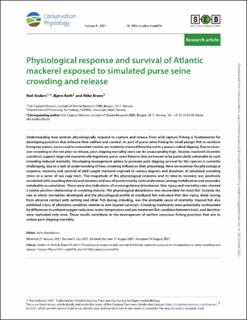| dc.description.abstract | Understanding how animals physiologically respond to capture and release from wild capture fishing is fundamental for developing practices that enhance their welfare and survival. As part of purse seine fishing for small pelagic fish in northern European waters, excess and/or unwanted catches are routinely released from the net in a process called slipping. Due to excessive crowding in the net prior to release, post-slipping mortality rates can be unacceptably high. Atlantic mackerel (Scomber scombrus) support large and economically important purse seine fisheries but are known to be particularly vulnerable to such crowding-induced mortality. Developing management advice to promote post-slipping survival for this species is currently challenging, due to a lack of understanding of how crowding influences their physiology. Here we examine the physiological response, recovery and survival of wild caught mackerel exposed to various degrees and durations of simulated crowding stress in a series of sea cage trials. The magnitude of the physiological response and its time to recovery was positively correlated with crowding density and duration and was characterized by cortisol elevation, energy mobilization and anaerobic metabolite accumulation. There were also indications of osmoregulatory disturbance. Skin injury and mortality rates showed a similar positive relationship to crowding density. The physiological disturbance was recoverable for most fish. Instead, the rate at which mortalities developed and the physiological profile of moribund fish indicated that skin injury, likely arising from abrasive contact with netting and other fish during crowding, was the probable cause of mortality. Injured fish also exhibited a loss of allometric condition relative to non-injured survivors. Crowding treatments were potentially confounded by differences in ambient oxygen reduction, water temperature and pre-treatment fish condition between trials, and densities were replicated only once. These results contribute to the development of welfare conscious fishing practices that aim to reduce post-slipping mortality. | en_US |
